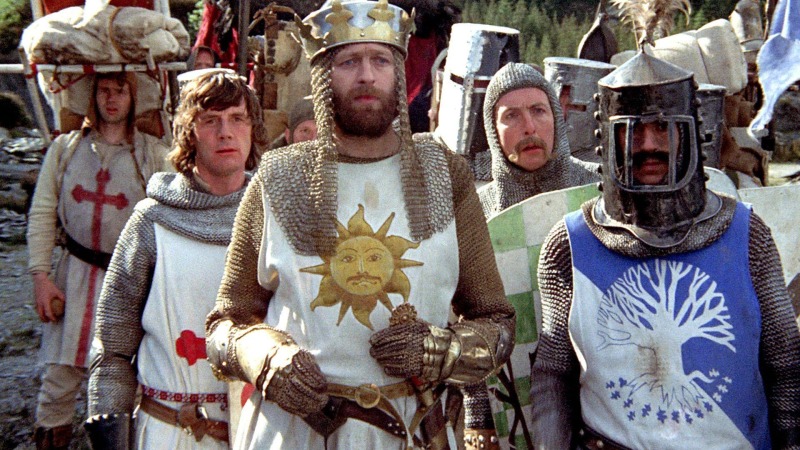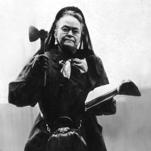The 50 Best Movies on Amazon Prime Right Now (October 2025)

The best movies on Amazon Prime are certainly out there, but finding them can sometimes feel like panning for gold in an endless sea of silt. Amazon Prime Video is a streaming treasure trove teeming with some of the most esoteric and wonderful underseen movies of the past 80 years, though good selections can feel nearly impossible to cull from the sometimes overwhelming glut of weirdly terrible movies buried in the streamer’s nether regions. Sure, Amazon has that weird horror movie, or that great film noir, but how in the world are you and your grandmother supposed to know that? Coupled with the counter-intuitive, migraine-inducing browsing, and the service’s penchant for dropping a title unexpectedly only for it to reappear under a different link just as unexpectedly, it makes sense that Amazon’s best film offerings are a little tricky to nail down.
Who can keep track of any of this stuff?
Well, we can. Or, at least, we try. While Amazon Prime’s movie library comes and goes every month (sometimes churning through dozens of titles), we at Paste have curated our Best Movies on Amazon list with that difficulty in mind. We’ll be updating this list regularly to make sure it’s as fresh and accurate as possible, highlighting both Amazon originals and gems buried deep in its content mine. Ranging from the Small Axe series to incredible anime and horror movies, our picks have got your back, no matter the genre you’re after.
Here are the 50 best movies on Amazon Prime right now:
1. Let the Right One In
Year: 2008
Director: Tomas Alfredson
Stars: Kåre Hedebrant, Lina Leandersson, Per Ragnar, Ika Nord, Peter Carlberg
Rating: R
Vampires may have become cinema’s most overdone, watered-down horror villains, aside from zombies, but leave it to a Swedish novelist and filmmaker to reclaim frightening vampires by producing a novel and film that turned the entire genre on its head. Let the Right One In centers around the complicated friendship and quasi-romantic relationship between 12-year-old outcast Oskar and Eli, a centuries-old vampire trapped in the body of an androgynous (although ostensibly female) child who looks his same age. As Oskar slowly works his way into her life, drawing ever-closer to the role of a classical vampire’s human “familiar,” the film questions the nature of their bond and whether the two can ever possibly commune on a level of genuine love. At the same time, it’s also a chilling, very effective horror film whenever it chooses to be, especially in the absolutely spectacular final sequences, which evoke Eli’s terrifying abilities with just the right touch of obstruction to leave the worst of it in the viewer’s imagination. The film received an American remake in 2010, Let Me In, which has been somewhat unfairly derided by film fans sick of the remake game, but it’s another solid take on the same story that may even improve upon a few small aspects of the story. Ultimately, though, the Swedish original is still the superior film thanks to the strength of its two lead performers, who vault it up to become perhaps the best vampire movie ever made. —Jim Vorel
2. One Night in Miami
Year: 2021
Director: Regina King
Stars: Kingsley Ben-Adir, Eli Goree, Aldis Hodge, Leslie Odom Jr
Rating: R
A barebones summary of One Night in Miami sounds like a dude’s delight movie: Four men out on the town, no attachments to keep them in line, and a limit to their evening revelry that extends skyward. But the four men are Sam Cooke, Cassius Clay, Jim Brown, and most of all Malcolm X; the town is actually the Magic City; and the specific evening is February 25, 1964, when heavyweight boxing champion Sonny Liston crossed gloves with Clay and lost his title in an upset. Subjects crossing the characters’ lips include, of course, boxing, and women, and rowdiness, but they’re joined by other, more important subjects like Black American identity, American identity, and how the two interact with one another. But that doesn’t rob One Night in Miami of the “delight” clause, thanks in no small part to crackling performances by a cast comprising a cadre of exceptional young actors (Eli Goree, Leslie Odom Jr., Aldis Hodge, Kingsley Ben-Adir), and directed with cool confidence by Regina King in her feature debut. Her adaptation of Kemp Powers’ stage play is a historical document written to presuppose what conversations these fellows might’ve had in private and away from prying ears, a compelling fiction rooted in reality. It’s also thoroughly entertaining, witty, and exuberant. This isn’t a film about meaningless carousing. It’s about conversations that actually matter. —Andy Crump
3. Monty Python and the Holy Grail
Year: 1975
Director: Terry Gilliam, Terry Jones
Stars: Graham Chapman, Eric Idle, Michael Palin, John Cleese, Terry Gilliam, Terry Jones
Rating: PG
It sucks that some of the shine has been taken off Holy Grail by its own overwhelming ubiquity. Nowadays, when we hear a “flesh wound,” a “ni!” or a “huge tracts of land,” our first thoughts are often of having full scenes repeated to us by clueless, obsessive nerds. Or, in my case, of repeating full scenes to people as a clueless, obsessive nerd. But, if you try and distance yourself from the over-saturation factor, and revisit the film after a few years, you’ll find new jokes that feel as fresh and hysterical as the ones we all know. Holy Grail is, indeed, the most densely packed comedy in the Python canon. There are so many jokes in this movie, and it’s surprising how easily we forget that, considering its reputation. If you’re truly and irreversibly burnt out from this movie, watch it again with commentary, and discover the second level of appreciation that comes from the inventiveness with which it was made. It certainly doesn’t look like a $400,000 movie, and it’s delightful to discover which of the gags (like the coconut halves) were born from a need for low-budget workarounds. The first-time co-direction from onscreen performer Terry Jones (who only sporadically directed after Python broke up) and lone American Terry Gilliam (who prolifically bent Python’s cinematic style into his own unique brand of nightmarish fantasy) moves with a surreal efficiency. —Graham Techler
4. Hundreds of Beavers
Year: 2024
Director: Mike Cheslik
Stars: Ryland Brickson Cole Tews, Olivia Graves, Wes Tank
Rating: NR
Hundreds of Beavers is a lost continent of comedy, rediscovered after decades spent adrift. Rather than tweaking an exhausted trend, the feature debut of writer/director Mike Cheslik is an immaculately silly collision of timeless cinematic hilarity, unearthed and blended together into something entirely new. A multimedia extravaganza of frozen idiocy, Hundreds of Beavers is a slapstick tour de force—and its roster of ridiculous mascot-suited wildlife is only the tip of the iceberg. First things first: Yes, there are hundreds of beavers. Dozens of wolves. Various little rabbits, skunks, raccoons, frogs and fish. (And by “little,” I mean “six-foot stuntmen in cheap costumes.”) We have a grumpy shopkeeper, forever missing his spittoon. His impish daughter, a flirty furrier stuck behind his strict rage. And one impromptu trapper, Jean Kayak (co-writer/star Ryland Brickson Cole Tews), newly thawed and alone in the old-timey tundra. Sorry, Jean, but you’re more likely to get pelted than to get pelts. With its cartoonish violence and simple set-up comes an invigorating elegance that invites you deeper into its inspired absurdity. And Hundreds of Beavers has no lack of inspiration. The dialogue-free, black-and-white comedy is assembled from parts as disparate as The Legend of Zelda, Charlie Chaplin’s The Gold Rush, JibJabs, Terry Gilliam animation, Guy Maddin and Jackass. Acme is namechecked amid Méliès-like stop tricks and Muppety puppetry, while its aesthetic veers from painting broad violence upon a sparse snowy canvas to running through the shadowy bowels of an elaborate German Expressionist fortress. Guiding us through is Tews. He’s a wide-eyed mime with a caricatured lumberjack body, expertly gauging his expressions and sacrificing his flesh for the cause. His performance takes a little from the heavy-hitters of the form: The savvy romanticism of Harold Lloyd, the physical contortions of Buster Keaton, the underdog struggles of Charlie Chaplin, and the total bodily commitment of all three. You don’t get great physical comedy accidentally. Just as its intrepid idiot hero forges bravely on despite weathering frequent blows to the head, impaled extremities and woodland beatings, Hundreds of Beavers marches proudly towards the sublime transcendence of juvenilia. In its dedication to its own premise, Hundreds of Beavers reaches the kind of purity of purpose usually only found in middle-school stick-figure comics or ancient Flash animations—in stupid ideas taken seriously. One of the best comedies in the last few years, Hundreds of Beavers might actually contain more laughs than beavers. By recognizing and reclaiming the methods used during the early days of movies, Mike Cheslik’s outrageous escalation of the classic hunter-hunted dynamic becomes a miraculous DIY celebration of enduring, universal truths about how we make each other laugh.–Jacob Oller
5. Dìdi
Year: 2024
Director: Sean Wang
Stars: Izaac Wang, Joan Chen
Rating: R
A gutshot coming-of-age story aimed directly at those former-teenagers who weathered the great transition from MySpace to Facebook, writer/director Sean Wang’s Dìdi is—like so much backwards-looking media about youth—almost more painful than poignant. It’s not upsetting, nor is it overly invested in tricking tears out of us. It’s just so specifically observed that you’ll be hiding your head in your hands, ashamed that you were ever as foolish, cowardly, insolent, horny and ridiculous as Chris Wang (Izaac Wang). Contained within the lifespan of Wang’s braces, Dìdi‘s summer dramedy tracks the transition between middle and high school for his pack of SoCal pals. Wang’s home life—as a Taiwanese American who lives with his mom (Joan Chen, wistful and playful as always), sister and grandmother—drapes another layer of specificity onto the lived-in script from Sean Wang (who was nominated for an Oscar this past year for Nǎi Nai & Wài Pó, a doc about his own grandmothers). Most of the movie is spent in Wang’s own blended social world of screens and skaters, but these brief interludes attempt to establish a deeper emotional core for a movie that already builds one through period-appropriate signifiers: The aloof AIM conversations about everything and nothing; the social politics of blocking a half-dated crush; the show-offy recitation of stand-up bits in front of girls, pretending like you came up with the anecdotes and punchlines. These are all embarrassing, moving, nostalgic and hilarious. It’s like putting your tween diary on the big screen, passages broken up by slides of your oldest social media posts. Sean Wang tears through this unflinching time capsule with an energetic cuteness that still has a hateful underbelly, ready to be exposed by its pubescent boys at the first sign of danger. It’s a companion piece of cringe-anthropology to accompany Eighth Grade, the familiar plot beats drawing their power from the exact year-month-day its setting exudes from every Paramore t-shirt and Motion City Soundtrack needledrop. Dìdi doesn’t break a lot of ground, but the warm return to the late ’00s will be an uncanny flashback for the right audience. —Jacob Oller
6. Strawberry Mansion
Year: 2022
Director: Kentucker Audley, Albert Birney
Stars: Kentucker Audley, Reed Birney, Penny Fuller, Grace Glowicki, Linas Phillips
Rating: NR
The intangible logic of our subconscious minds is what fuels Strawberry Mansion, a dazed and dreamy jaunt through nostalgic reverie and existential anxieties. Co-directed by Albert Bimey and Kentucker Audley (who also stars), the film is an exercise in creating a dreamscape by way of capturing texture—a venture that renders enthralling, gorgeous and unsettling images as a result. Not only is Strawberry Mansion a genuine feast for the eyes, but its plot is far more cohesive and calculated than most dream-like narratives care to strive for. This ensures that none of the audience falls into their own movie-induced slumber while also serving as a boon to the project’s ethos—one that desperately urges us to pay close attention to the details and potential meanings of our dreams, as they might just be the very key to our survival. Set in the not-so-distant future, Strawberry Mansion follows James Preble (Audley), an auditor who works for a governmental agency that regulates “dream taxes,” a result of ads being projected into our most intimate mental moments. When he arrives at a sprawling Victorian abode with a magenta exterior, he believes he’s simply making a routine house call to address unpaid back taxes. An eccentric older woman named Bella (Penny Fuller) answers the door, and says she’ll only allow the tax man inside if he complies with her code: “To enter, you must lick the ice cream cone.” A bite-sized scoop of strawberry ice cream sits atop a small sugar cone—and though he’s reluctant at first, James eventually relents and licks the ice cream cone, a decision which effectively begins his odyssey of wading through thousands of VHS tapes containing Bella’s dreams. While he’s officially meant to be viewing these in order to collect data, he begins to fall in love with the younger version of Bella (Grace Glowicki) that serves as her constant avatar in dreamland. In fact, the auditor is so smitten that he hardly realizes the conspiracy he’s unwittingly landed himself within, spending all day in a clunky headset instead of piecing together the significance of how advertising and unpaid taxes converge. Always engrossing yet never laboriously abstract, Strawberry Mansion creates a delectable realm of reverie that’s easy to get lost in—though it can also feel tensely labyrinthine at times. Musing on the human capacity for love, greed and tenacity, it’s likely to make one misty-eyed during certain (sparse) moments of tranquility and personal peace, reflecting the beauty in realizing our own aspirations and impulses instead of blindly accepting what we’re told to be and do. The life that best suits us might be far-flung from the life we’re currently living, and sometimes it takes a ridiculous situation to unmoor us from the constraints of routine and ritual. Just remember: When in doubt, always be sure to lick the strawberry ice cream cone.–Natalia Keogan
7. Manchester by the Sea
Year: 2016
Director: Kenneth Lonergan
Stars: Casey Affleck, Michelle Williams, Kyle Chandler
Rating: R
Loss and grief—and the messy, indirect ways people cope with the emotional fallout—were the dramatic linchpins of writer-director Kenneth Lonergan’s first two films, You Can Count on Me and Margaret. And so it is again with Manchester by the Sea, a commanding, absorbing work in which the sum of its impact may be greater than any individual scenes. As opposed to the intimate, short-story quality of You Can Count on Me, Manchester by the Sea bears the same sprawling ambition as Margaret, Lonergan draping the proceedings in a tragic grandeur that sometimes rubs against the film’s inherently hushed modesty. Casey Affleck as Lee Chandler is quietly magnetic as a man who can’t express himself at a time when he really needs to step up and be the patriarchal figure. Lucas Hedges and Kyle Chandler are also both quite good, their characters buried deep in the man’s-man culture of the East Coast communities in which the film is set. But especially terrific is Michelle Williams as Lee’s ex-wife, who has played haunted wives before, in Brokeback Mountain and Shutter Island. Here, though, she really pierces the heart: Her character never stopped loving Lee, but her brain told her she had to if she was ever going to move on with her life. In this film, she’s actually one of the lucky ones. Tragedies drop like bombs in Manchester By the Sea, and the ripple effects spread out in all directions. The movie’s ending isn’t exactly happy, but after all the Chandlers have gone through, just the possibility of acceptance can feel like a hard-earned victory. —Tim Grierson
8. You Were Never Really Here
Year: 2018
Director: Lynne Ramsay
Stars: Joaquin Phoenix, Ekaterina Samsonov, John Doman, Judith Roberts, Alex Manette, Alessandro Nivola
Rating: R
Lynne Ramsay has a reputation for being uncompromising. In industry patois, that means she has a reputation for being “difficult.” Frankly, the word that best describes her is “unrelenting.” Filmmakers as in charge of their aesthetic as Ramsay are rare. Rarer still are filmmakers who wield so much control without leaving a trace of ego on the screen. If you’ve seen any of the three films she made between 1999 and 2011 (Ratcatcher, Morvern Callar, We Need to Talk About Kevin), then you’ve seen her dogged loyalty to her vision in action, whether that vision is haunting, horrific or just plain bizarre. She’s as forceful as she is delicate. Her fourth film, You Were Never Really Here—haunting, horrific and bizarre all at once—is arguably her masterpiece, a film that treads the line delineating violence from tenderness in her body of work. Calling it a revenge movie doesn’t do it justice. It’s more like a sustained scream. You Were Never Really Here’s title is constructed of layers, the first outlining the composure of her protagonist, Joe (Joaquin Phoenix, acting behind a beard that’d make the Robertson clan jealous), a military veteran and former federal agent as blistering in his savagery as in his self-regard. Joe lives his life flitting between past and present, hallucination and reality. Even when he physically occupies a space, he’s confined in his head, reliving horrors encountered in combat, in the field and in his childhood on a non-stop, simultaneous loop. Each of her previous movies captures human collapse in slow motion. You Were Never Really Here is a breakdown shot in hyperdrive, lean, economic, utterly ruthless and made with fiery craftsmanship. Let this be the language we use to characterize her reputation as one of the best filmmakers working today. —Andy Crump
9. Knives Out
Year: 2019
Director: Rian Johnson
Stars: Ana de Armas, Daniel Craig, Chris Evans, Jamie Lee Curtis, Michael Shannon, Don Johnson
Rating: PG-13
Knives Out is the type of movie that’s not so much a dying breed as one that just occurs uncommonly “in the wild.” Hollywood seems to release a new take on the classic (i.e., Agatha Christie-imprinted) murder mystery “who dunnit”—where an eccentrically mannered detective attempts to figure out who amongst a roomful of suspects has committed murder most foul—every five-to-10 years. For most viewers, the pleasures of such movies go beyond trying to figure out the killer before the detective does—there’s also typically a star-studded cast chewing up the scenery. Beyond dependable Christie fare like Death on the Nile (1978) and Murder on the Orient Express (2017), there’s Clue (1985), Gosford Park (2001) and now Rian Johnson’s Knives Out. Johnson’s latest starts out in classic who-dunnit fashion—acclaimed mystery writer Harlan Thrombey (Christopher Plummer) is found dead by apparent suicide the night after gathering his family together and delivering a series of unpopular messages. Enter the local police (led by Lakeith Stansfield’s Det. Lt. Elliott) and eccentrically mannered (there we go!) private detective Benoit Blanc (Daniel Craig). Suspects are interrogated. Secrets are revealed. Then, right as the viewer is gearing up to lay some Sherlock Holmes/Hercule Poirot/Encyclopedia Brown-level discernment on all this, Johnson reveals what happened to the elder Thrombey. This flips the entire experience for the viewer, as they go from trying to figure out what happened to wondering if the truth will be discovered. Much as he did with Dashiell Hammett-style noir in his debut, Brick, Johnson shows both a reverence for and a willingness to tinker with the tropes and formula underpinning his story. It’s all delightful to watch. If, ultimately, Knives Out accomplishes what it sets out to do—which might sound like faint or even damning praise with another film or in another genre—here it’s meant as the sincerest of plaudits. —Michael Burgin
10. Memories
Year: 1995
Director: Koji Morimoto, Tensai Okamura, Katsuhiro Otomo
Stars: Tsutomu Isobe, Hideyuki Hori, Yuu Hayashi
Rating: NR
After wrapping production on Akira in 1988, Katsuhiro Otomo returned in 1995 to helm his third anthology collection of short films, titled Memories. Initially scripted around the theme of the collection’s namesake, the anthology eventually yielded a series of three shorts, each directed by one of three of the most acclaimed directors working at the time, Otomo included. The collection’s first segment, “Magnetic Rose,” is unanimously praised as the anthology’s best and for good reason. Directed by Koji Morimoto and scripted by Satoshi Kon, “Magnetic Rose” is emblematic of the themes of perception, identity and uncertainty, which exemplify Kon’s work at its best, depicting the terrifying story of a deep space salvage cruise’s ensnarement in the siren wiles of an aristocratic opera singer. The anthology’s other two installments, Tensai Okamura’s “Stink Bomb” and Otomo’s “Cannon Fodder,” are worth the price of admission as well, the former a crassly comedic take on an extinction-level crisis and the latter a wartime parable animated with a intriguing Terry Gilliam-esque art style in one long take. Whatever your palate as anime film-goer, Memories is not to be missed.
11. Challengers
Year: 2024
Director: Luca Guadagnino
Stars: Zendaya, Josh O’Connor, Mike Faist
Rating: R
There’s no need to know, or even enjoy, anything about the sport of tennis to find enjoyment in director Luca Guadagnino’s Challengers. Still, tennis is inextricably knotted to its sensuous love triangle, which evolves over the course of 13 tumultuous years, climaxing with a match between two estranged players whose love story eclipses the more overt romance between the pair and Zendaya’s tennis prodigy, Tashi Duncan. But it is a story of desire, love, power and co-dependency between three gifted young athletes who all hold that nagging fear, even in their early 30s, that their best years are behind them. The only thing that can reinvigorate their lost sparks is base, animalistic competition, like that which fueled their chaotic threesome over a decade prior to the lowly Fire Town challenger tournament in New Rochelle, New York. We first meet Tashi and Art Donaldson (Mike Faist), married and with a mostly neglected young daughter, after Tashi’s best tennis-playing days are behind her (due to a consequential leg injury) and Art is all but bereft of his mojo. In an effort to get his head back in the game and out of early retirement, Tashi enrolls him in a challenger: A small, U.S. Open qualifier that should be beneath an athlete whose face adorns ads the size of building facades. The goal is to have Art compete against players who are obviously below him in order to loosen him up and regain his confidence. The only problem is, it’s the same kind of minor sporting event that attracts a hard-up guy like Patrick Zweig (Josh O’Connor). Thirteen years earlier, Patrick and Art were both just two young tennis studs who once jerked off together (what guys can’t say the same?), in love with the same beautiful woman. Thirteen years later, one of them got the girl, the other is cosplaying as poor, and the former two haven’t spoken to the latter in years. The film is just as dynamic as its stars. Rapid cuts give the film a cohesive, kinetic rhythm that keeps the story in a near-constant state of momentum, and none of the frames the camera cuts to are superfluous compositions. This is matched by the occasionally dizzying camerawork from Gudagnino’s Suspiria cinematographer (also Apichatpong Weerasethkul’s on Memoria) Sayombhu Mukdeeprom. Challengers surprised me. It’s a grandiose, propulsive, erotic follow-up to the dull, Tumblr-core emo of Bones and All, and I found myself enthralled by Guadagnino’s latest, in which three of our hottest young actors convincingly, tantalizingly explore alternating dynamics of power and sexuality. Challengers isn’t really a film for tennis fans—it’s a film for fans of guys being a little gay for each other, and also fans of the kind of explosive yearning that’s even hotter than the sex scenes we all like to complain don’t exist anymore.–Brianna Zigler
12. The Big Sick
Year: 2017
Director: Michael Showalter
Stars: Kumail Nanjiani, Zoe Kazan, Holly Hunter
Rating: R
The Big Sick can sometimes be awfully conventional, but among its key assets is its radiant view of its characters. Based on the first year in the relationship of married screenwriters Kumail Nanjiani and Emily V. Gordon, this indie rom-com has a mildly risky structure and some trenchant observations about the culture clashes that go on in immigrant families living in America. But what cuts deepest is just how profoundly lovable these people are. That’s not the same as being cutesy: Rather, The Big Sick is defiantly generous, understanding that people are horribly flawed but also capable of immeasurable graciousness when the situation requires. So even when the film stumbles, these characters hold you up. Nanjiani plays a lightly fictionalized version of his younger self, a struggling Chicago stand-up who is having as much success in his career as he in his dating life. Born into a Pakistani family who moved to the United States when he was a boy, he’s a dutiful son, despite lying about being a practicing Muslim and politely deflecting the attempts of his parents (Anupam Kher, Zenobia Shroff) to set him up in an arranged marriage. That’s when he meets Emily (Zoe Kazan), an American grad student with whom he’s instantly smitten. She swears she doesn’t want a relationship, but soon they fall for one another—even though Kumail knows it can’t work out. What’s most radical about The Big Sick is its optimistic insistence that a little niceness can make all the difference. —Tim Grierson
13. The Texas Chain Saw Massacre
Year: 1974
Director: Tobe Hooper
Stars: Marilyn Burns, Paul A. Partain, Edwin Neal, Jim Siedow, Gunnar Hansen
Rating: R
One of the most brutal mainstream horror films ever released, The Texas Chain Saw Massacre, based on notorious Wisconsin serial killer Ed Gein, resembles art-house verité built on the grainy physicality of its flat Texas setting. Plus, it introduced the superlatively sinister Leatherface, the iconic chainsaw-wielding giant of a man who wears a mask made of human skin, whose freakish sadism is upstaged only by the introduction of his cannibalistic family with whom he resides in a dilapidated house in the middle of the Texas wilderness, together chowing on the meat Leatherface and his brothers harvest, while Grandpa drinks blood and fashions furniture from victims’ bones. Still, The Texas Chain Saw Massacre might not be the goriest horror film ever made, but as an imaginal excavation of the subterranean anxieties of a post-Vietnam rural American populace, it’s pretty much unparalleled. Twisted, dark and beautiful all at once, it careens through a wide variety of tones and techniques without ever losing its singular intensity. (And there are few scenes in this era of horror with more disturbing sound design than the bit where Leatherface ambushes a guy with a single dull hammer strike to the head before slamming the metal door shut behind him.) –Rachel Haas and Brent Ables
14. Small Axe: Alex Wheatle
Year: 2020
Director: Steve McQueen
Stars: Sheyi Cole, Robbie Gee, Johann Myers
Rating: NR
Alex Wheatle is a coming of age story based on the early life of the eponymous award-winning YA author and is the penultimate film of McQueen’s Small Axe collection. Set in the ‘70s and early ‘80s, we follow Alex from his childhood in an orphanage of Dickensian cruelty to his Brixton youth, where he connects with his Blackness, to his being nurtured by a paternalistic Rastafarian cellmate in prison. Alex Wheatle is accomplished and devastating, with dynamic cinematography, a phenomenal soundtrack and a heartbreaking central debut performance from Sheyi Cole. In many ways, it feels like a melding of the other four Small Axe films: The systemic racism of Mangrove, the musical escapism of Lover’s Rock, the daddy issues of Red, White & Blue and the childhood cruelty of Education. But in its thematic overlapping, Alex Wheatle undermines its own significance. It doesn’t have the distinct identity of the other films and, while it’s always a pleasure to watch filmmaking at McQueen’s level, it doesn’t leave a lasting impression.—Leila Latif
15. Nosferatu
Year: 2024
Director: Robert Eggers
Stars: Bill Skarsgård, Nicholas Hoult, Lily-Rose Depp, Aaron Taylor-Johnson, Emma Corrin, Willem Dafoe
Rating: R
What a strange yet hypnotizing task, the business of remaking Nosferatu, only slightly mitigated by the fact that it’s been done before. F.W. Murnau’s original 1922 silent film, subtitled A Symphony of Horror, adapted Bram Stoker’s novel Dracula without permission before the authorized 1931 edition (and is not especially less faithful to the novel than that early Universal Horror classic); then, in 1979, Werner Herzog remade the film as Nosferatu the Vampyre, a more verdant, eerily quiet version, expertly suffused with the grim unease that it could be taking place closer to our world.
That sense of creeping inevitability bleeds into the 2024 edition of Nosferatu, adapted by Robert Eggers – whose film that comes closest to a contemporary setting, The Lighthouse, takes place around the time Stoker’s novel was published. His Nosferatu echoes its official source, as the earlier film echoed its inspiration: In the nineteenth century, Thomas Hutter (Nicholas Hoult) travels to the remote castle of Count Orlok (Bill Skarsgård), in the scenic Carpathian Mountains, to complete a real-estate transaction. Orlok becomes entranced by a photo of Thomas’s wife Ellen (Lily-Rose Depp), and when he makes his way to his new home, he brings vampiric pestilence with him as he stalks his adopted hometown, and Ellen in particular, with a kind of rigorously evil devotion. To call it love or even lust would not quite do justice to the totemic figure he cuts. This Orlok is neither the beastly, rodent-like version played by Max Shreck nor the elegant, be-caped Bela Lugosi. Get ready for a main vamp with a beard more prominent than any fangs, somewhere between a lumberjack and a living tree. This Orlok gives the impression of a vampire who audibly gulps down blood not exactly out of hunger, but to collect and taste what he lacks. —Jesse Hassenger
16. Argentina, 1985
Year: 2022
Director: Santiago Mitre
Stars: Ricardo Darín, Peter Lanzani, Claudio Da Passano, Alejandra Flechner, Norman Briski
Rating: R
The horrendous historical reckoning inherent to Santiago Mitre’s Argentina, 1985 is unmistakably evoked through the film’s title. The Argentine director, who is best known for political dramas that examine the country’s social follies, meticulously recreates the circumstances surrounding what’s considered the most ambitious trial against fascist human rights violations in Latin American history. Co-written by Mitre and Mariano Llinás (the filmmaker behind the four-part epic La Flor), Argentina, 1985 is a stylistically assured procedural that manages to tastefully recount the mass torture, rape, killing and “disappearance” of more than 30,000 Argentine civilians by the military dictatorship during the so-called Dirty War that lasted nearly a decade from 1974 through 1983. Through capturing victim testimonies as they were presented in court during this months-long trial as well as the dogged pursuit for justice by a ragtag team of bravely dedicated prosecutors, the film wholly resists sensationalization, opting instead to faithfully reconstruct the events that culminated in a landmark win for social justice amid a shakily budding democracy. Ricardo Darín plays Julio César Strassera, the lead prosecutor of the Trial of the Juntas, who is initially fearful over the prospect of publicly presiding over the case against these murderous fascists, none more notorious than one-time acting ruler Jorge Rafael Videla. Obviously, Strassera’s apprehension is more than warranted: With the national wounds still raw from the junta’s merry mass extermination of citizens accused of opposing their rule, he immediately begins to fret for the lives of his wife and children. This anxiety manifests in subtle and overt ways — he loses sleep, relies on nerve-numbing cocktails and begins taking his son to school on the subway instead of risking the threat of car bombs being planted in his modest sedan. However, the pressure of this undertaking is partially lifted from his shoulders when deputy prosecutor Luis Moreno Ocampo (Peter Lanzani) joins the case. Together, they select a legal team to aid in their extensive, labor-intensive hunt for witnesses, incriminating documents and written statements that detail the nauseating cruelty and violence of the junta. While much of the film is focused on the collection of evidence and ensuing court case, Argentina, 1985 is also masterfully imbued with period-specific details in the costume and set design, painstakingly emulated from archival footage. Sumptuously captured by cinematographer Javier Juliá’s lens, these visual facets make the two-hour-and-twenty-minute runtime melt by. Of course, the film’s streamlined, never-clunky narrative is no doubt bolstered by Llinás’ involvement as co-writer. After helming an 808-minute feature in 2018, an 140-minute undertaking must feel like light work.—Natalia Keogan
17. Battle Royale
Year: 2000
Director: Kinji Fukasaku
Stars: Tatsuya Fujiwara, Aki Maeda, Tarô Yamamoto
Rating: R
It’s OK to compare Battle Royale to The Hunger Games movies—or, rather, to find how the lasting accomplishments of the latter franchise were essentially done better and with so much more efficiency by the former—because you probably will anyway. Battle Royale, like the immensely successful four-film crash course in crafting an action star who is really only a symbol of an action star, chronicles a government-sanctioned battle to the death between a group of teens on a weird, weapon-strewn island. (There are even regular island-wide announcements of the day’s dead as the sun sets on the remaining children.) Yet, Battle Royale is so lean in its exposition, so uninterested in dragging out its symbolism or metaphor, that one can’t help but marvel at how cleanly Fukasaku (who had a full career behind him when he made this, only three years before he died) can lend depth to these children, building stakes around them to the point that their deaths matter and their doomed plights sting. What the director can do with such a tenuous premise (which The Hunger Games takes multiple films to do, and without a single ounce of levity) is astounding—plus, he wrangled Takeshi Kitano to play the President Snow-type character, which Kitano does to near-perfection. That Battle Royale II sets out to up the stakes of the first film, especially given the first film’s crazy success in Japan, is to be expected, but stick to the first: Battle Royale will make you care about kids murdering each other more than you (probably) would anyway. —Dom Sinacola
18. Mission: Impossible—Dead Reckoning Part One
Year: 2023
Director: Christopher McQuarrie
Stars: Tom Cruise, Ving Rhames, Simon Pegg, Rebecca Ferguson, Hayley Atwell, Vanessa Kirby, Esai Morales, Pom Klementieff, Henry Czerny, Shea Whigham, Greg Tarzan Davis, Cary Elwes
Rating: PG-13
A scene in Mission: Impossible—Dead Reckoning Part One defines all Tom Cruise is and will ever be, arguably charting—in the language of death-defying action and in the voice of Hollywood A-lister beatitudes—the whole arc of contemporary blockbuster franchise filmmaking. Recovering with his team of Impossible Mission Force (IMF) agents following one of the worst catastrophes they’ve yet faced, Ethan Hunt (Cruise, asexual and totemic) admits to a new team member that, while he can’t guarantee he will keep them safe, he can guarantee that he’ll care more about their lives than his own. Not expecting such unmitigated humanity in the midst of such potential worldwide cataclysm, the new agent stares through welling tears. “But you don’t know me,” they say. “Does it matter?” Tom Cruise and Ethan Hunt both respond. Whether Cruise is capable of making a film that doesn’t reckon with his legacy? That’s not this one’s job. Helmed by director Christopher McQuarrie on his third go at M:I, Dead Reckoning Part One reaches back 28 years to the first film, not only bringing back Kittridge (Henry Czerny) as the head of the IMF, appointed apparently after Director Hunley’s (Alec Baldwin, ejected from the franchise with impeccable timing) murder in Fallout, but culling reverently from De Palma’s penchant for paranoid close-ups and canted angles, for long-held shots obsessed with the creased faces of defiantly sweaty men, studying their buttery eyes for omens. Dead Reckoning Part One’s plot, as convoluted as the best in the franchise, comes together stupendously. Every facet, from sound and set design to Cruise’s sheer athleticism to how McQuarrie knows exactly where to place the camera to embrace that athleticism, coalesces into a very real, often breathtaking sense of peril that’s mostly absent from every other IP that’s lasted this long. Cruise is showing us what kind of death it takes to achieve the immortality cinema promises.—Dom Sinacola
19. We Need to Talk About Kevin
Year: 2012
Director: Lynne Ramsay
Stars: Tilda Swinton, John C. Reilly, Ezra Miller
Rating: R
We Need To Talk About Kevin concerns the experience of a mother (Tilda Swinton) struggling with the aftermath of a school massacre carried out by her son (Ezra Miller). In its narrative construction, it draws upon two key tropes: that of the “whydunnit” thriller, in which the mystery of the perpetrator’s motivations are a driving factor, and that of the family horror, in which some dark element tears a traditional household apart. Indeed, the real horror is not that a teenager chose total negation over the banality of normative family life—it’s that these appeared to be the only two choices available. Tilda Swinton is brilliant in the starring role as a mother who grapples with guilt about what her son has done and reflects on his childhood, wondering what, if anything, could possibly have been done differently when one gives birth to a “bad seed.” The heartbreaking nature of the film is perfectly encapsulated by the scene wherein Kevin as a child briefly drops his sociopathic tendencies while ill, giving Swinton’s character a brief chance to feel like a cherished mother, only to emotionally shut her out again as soon as his physical health returns, dashing her hopes that some kind of breakthrough had been made. —Donal Foreman
20. Evangelion 3.0+1.0: Thrice Upon a Time
Year: 2021
Director: Hideaki Anno, Mahiro Maeda, Katsuichi Nakayama, Kazuya Tsurumaki
Stars: Megumi Ogata, Megumi Hayashibara, Yuko Miyamura, Maaya Sakamoto, Akira Ishida, Kotono Mitsuishi
Rating: TV-MA
Since 1995, Neon Genesis Evangelion has penetrated the cultural consciousness with giant robots, angsty teens and esoteric Biblical references. It is the story of Shinji Ikari, a young boy destined to pilot a giant robot called Unit-01 in a future where creatures called Angels are destined to destroy humanity. But Shinji resists his fate, complaining at every turn and freezing with indecision as the survival of humanity lies on his shoulder. It is truly a one of a kind franchise, the brainchild of the genius and deeply depressed Hideaki Anno. It is a franchise that has plagued him for over 25 years, from a series to a slew of movies that worked to rewrite a dissatisfying ending. Now, Anno is finally done. With the release of his latest and last piece of Evangelion media, Evangelion 3.0+1.0: Thrice Upon a Time, the time of the Angels has come to an end. Thrice Upon a Time is the fourth Rebuild of Evangelion film, which is a complete retelling of the events from the original series. The final film in the universe of Shinji, Asuka, Rei and EVAs may not be the best place for franchise novices to start, but it should be a great motivator. Rarely do anime franchises end on such a pitch perfect note, but Anno shows it is possible with Evangelion 3.0+1.0: Thrice Upon a Time. After decades of grappling with what this series means to him and using it as a mechanism to process his own emotional baggage, Anno has finally found closure within his broken world full of angst and hope. This is a gasp of relief, a stifled sob of pride that punctuates a cultural milestone. With the release of this film, Anno is finally free.—Mary Beth McAndrews
21. The Return of the Living Dead
Year: 1985
Director: Dan O’Bannon
Stars: Clu Gulager, James Karen, Don Calfa, Thom Mathews, Linnea Quigley
Rating: R
John Russo is a huge unknown in terms of important figures in zombie cinema, at least among those who aren’t big horror geeks. Russo is the man who created the original story for Night of the Living Dead alongside George Romero, and thus is essentially one half of the driving force for the most famous zombie film of all time. After the two parted ways post-NOTLD, their settlement dictated that Russo would retain the rights to any future films with the phrase “living dead” in the title. Thus, Romero’s “of the dead” monikers in future films. Russo, meanwhile, wrote his sequel as a novel, which was then finally adapted as a film 17 years after the original NOTLD with extensive rewrites by director Dan O’Bannon. The result is one of the all-time zombie classics, a film that is equal parts gory and hilarious while making a concerted effort to capture the youth movement, art aesthetic and, especially, music of the mid-’80s. It’s influential in so many different ways: the comedic tone; the youth focus; the scapegoating of an American military experiment gone wrong as the genesis of the zombies. The zombies too have been completely redesigned with all-new capabilities—they’re intelligent, they can speak, they can move fast and, for the first time ever, they’re specifically targeting human brains. That last point was so influential and so ubiquitous in the genre after 1985 that it’s incorrectly been assumed by many people for decades that the Romero zombies are brain-eaters. For these reasons, ROTLD is undoubtedly one of the most significant zombie films ever. And by the way—with ROTLD, Day of the Dead, Demons and Re-Animator all being released in 1985, is it safe to say this was the greatest year in the history of zombie cinema? —Jim Vorel
22. The Wailing
Year: 2016
Director: Na Hong-jin
Stars: Kwak Do-won, Hwang Jung-min, Chun Woo-hee
Rating: NR
The U.S. title of Na Hong-jin’s new film, The Wailing, suggests tone more than it does sound. There is wailing to be heard here, yes, and plenty of it, but in two words Na coyly predicts his audience’s reaction to the movie’s grim tableaus of a county in spiritual strife. Na trades in doubt and especially despair more than in what we think of as “horror.” He isn’t out to terrify us. He’s out to corrode our souls, much in the same way that his protagonist’s faith is corroded after being subject to both divine and infernal tests over the course of the film. The Wailing unfolds in Gokseong County, an agricultural community nestled among South Korea’s southern provinces. It’s a lovely, bucolic setting that Na and his cinematographer, the incredible Hong Kyung-pyo, take fullest advantage of aesthetically and thematically. The hushed serenity blanketing The Wailing’s opening images creates an atmosphere of peace that Na is all too happy to subvert (similar to how he subverts Bible verses). The film’s first full sequence shatters the calm as Sergeant Jeon Jong-gu (Kwak Do-won, turning in a knockout performance) is called to the scene of a savage multiple murder. When Jong-gu shows up, all is bedlam; people are screaming and crying, emergency workers litter the area like ants at a gory picnic, and the killer sits in a stupor, unaware of neither the mayhem nor the vicious boils coating their skin. This is an incredibly creepy and oft-unsettling film, but Na finds the tug of disbelief far more upsetting than the sight of bodies cut apart and blood splattering the wall. What do you do when your holy authority figures fail you? What do you do when you can’t trust your perception? Na has made these ideas, though hardly new in the horror canon, his film’s full purpose, and his conclusions are devastatingly bleak. When The Wailing arrives at its final, spectacular half hour, you’ll vow never to ask these questions about your own life, ever. You may not leave the theater scared, but you will leave it scarred, which is by far a more substantive response than naked fear. —Andy Crump
23. Detour
Year: 1945
Director: Edgar G. Ulmer
Stars: Tom Neal, Ann Savage, Claudia Drake, Edmund MacDonald
A Poverty Row staple with an unknown cast peering into the post-war dark night of the soul, Detour has come to embody the best film noir has to offer—namely, that budget and schedule concerns indirectly enriched the artistic product, paring down a weightier script and even more bloated source novel into a precise, exquisitely sharp bit of storytelling economy. Trapped within the sweaty mind of always-broke jazz pianist Al Roberts (Tom Neal) as he heads West from New York to settle down with his girlfriend (Claudia Drake), a symbol of stable life for Roberts who absconded with his heart to try to “make it” in Hollywood, we’re stuck with only the unlucky guy’s version of events throughout his increasingly desperate trip. After all, his hitchhiking journey seems doomed to fail from the start, but it grows damn near bleak with the accidental cadaver-ing of a gregarious Charles Haskell (Edmund MacDonald) following a whirlwind buddy meet-cute, and then completely hopeless with the introduction of Vera (Ann Savage), an iconic femme fatale who doesn’t have to try hard to ensnare Roberts, by that point so far out of his league he’s got his pants pulled up well past his nipples. As much an efficient encapsulation of its genre as it is a noir drowning entirely within its own hell-bent nightmare, Detour is most impressive for how gracefully Ulmer can get the most out of so little. —Dom Sinacola
24. The Fall Guy
Year: 2024
Director: David Leitch
Stars: Ryan Gosling, Emily Blunt, Winston Duke, Aaron Taylor-Johnson, Hannah Waddingham, Stephanie Hsu
Rating: PG-13
The deceptive difficulty of action movies, comedies, and their intersection is being able to do something completely stupid with total straight-faced commitment. Like so many easily dismissed parts of film production, a punchline delivered with invested emotion is just as hard to pull off as a pratfall performed with total abandon. If either misses its mark by a hair, you fall flat on your face and leave the audience hating your smug performance or hyperactive flailing. It’s all the more impressive, then, that Ryan Gosling does it all in The Fall Guy. He plays stuntman Colt Seavers, living bruise, returning to action One Last Time in order to help his old flame Jody Moreno (Emily Blunt) on her first directorial effort, Metalstorm. That’s the simple set-up, designed to showcase the jock rock of filmmaking: A stunt spectacular combining the technical prowess and meathead charm of the dirtbag daredevils behind every awesome car crash and killer fight scene. And, thanks to Gosling—playing his role like his schmuck detective from The Nice Guys accidentally found himself in a Mission: Impossible—the film breezily flits between a savvy behind-the-scenes pastiche and a committed action rom-com. Ok, The Fall Guy owes its success to far more people than its leading man. That’s kind of its point. Directed by longtime stuntman David Leitch (with this film, distancing himself from solely being the less impressive half of the John Wick team) and written by Drew Pearce (one of Leitch’s Hobbs & Shaw scribes), The Fall Guy works best as an anti-blockbuster. It wants to blow shit up and wow us with its ballsy choreography, but it also wants to take the shine off these feats of movie magic. Funnier and more effective than most movies built upon a foundation of car chases and fistfights, The Fall Guy is smart enough to showcase its dumb action in a new and exciting way. Its affection is infectious, whether that’s for the art of filmmaking, the haywire pleasures of being on set, the adrenaline rush of a well-made gamble, or for finding someone special to share your simple corner of the world. The ambitious meta-film overcomes the baggage of trying to be both the movie of the summer and the movie that comments on those kinds of movies, hitting a cinematic sweet spot and singing the praises of stunt performers everywhere.–Jacob Oller
25. A Hero
Year: 2022
Director: Asghar Farhadi
Stars: Amir Jadidi, Mohsen Tanabandeh, Alireza Jahandideh, Sahar Goldoost, Fereshteh Sadr Orafaie, Sarina Farhadi
Rating: PG-13
What’s the price for having a conscience? Iranian master Asghar Farhadi’s A Hero spirals out a good deed to all its messy conclusions, providing fertile ground for the filmmaker’s command of aesthetic realism and closeknit interpersonal dynamics. Rahim (Amir Jadidi), a jailed debtor, returns a bag filled with money that he found on leave. The consequences from that act, pushed and prodded and wheedled by Farhadi’s script—which adds a deft understanding of social media to a sharply constructed web of relationships and reputations—are an endurance test for the tear ducts. Doomed nobility is the biggest ask for Jadidi, but his big toothy smile and world-beaten posture allow him to find the perfect amounts of charm (whether genuine or off-putting) or pathos (which we know he’d hate) in Rahim. Sahar Goldoost, Maryam Shahdaei and Alireza Jahandideh make the film a truly potent ensemble drama, while Farhadi’s daughter, Sarina Farhadi, has a memorable return to the screen a decade since her last role, in Farhadi’s A Separation.—Jacob Oller
26. Conclave
Year: 2024
Director: Edward Berger
Stars: Ralph Fiennes, Stanley Tucci, John Lithgow, Isabella Rossellini
Rating: PG
The pope is dead, long live the pope. In the papal election thriller Conclave, the Holy Father has ascended, and a different ascendency now grips the Vatican: which member of the College of Cardinals, hastily assembled in the sealed Sistine Chapel (the word conclave comes from the Latin cum clave, “with a key”), will receive a supermajority vote to become supreme pontiff of the Catholic Church. The traditional, closed-door design of the election invites an inherent layer of mystery and conspiracy, and the staggered voting process – the tallies of each vote are announced in front of the cardinals, giving them a brief recess to reconsider who is worth throwing their weight behind before having another go – provides an attractive structure for drama. Add an archbishop (Jacek Koman) breathlessly informing the conclave chief that one of the hopeful cardinals was dismissed by the pope just before he passed away, and the arrival of Benitez (Carlos Diehz), a Mexican cardinal on a secret, pope-approved mission in Kabul, and the sealed doors of the conclave become a pressure cooker for the Church’s future. —Rory Doherty
27. Small Axe: Red, White & Blue
Year: 2020
Director: Steve McQueen
Stars: John Boyega, Steve Toussaint
Rating: NR
What Red, White & Blue has going for it are two extraordinary performances from John Boyega and Steve Toussaint. Boyega is charming as the fiery and conflicted Leroy Logan, a Black scientist who—following on a racist police attack on his father—decides to join the force to reform it from the inside. His father is played with equally compelling ferocity and dignity by Toussaint. There is so much to love in this film, as McQueen leans into his skill at suspense—ratcheting up the tension with incomparable style—and brings out performances that are able to convey so much without saying a word. However, the script doesn’t match the rest of the film, with clunky exposition and uncharacteristic sentimentality weighing down the actors. At its core, Red, White & Blue is not about police reform. In fact almost all of Logan’s fascinating career accomplishments take place long after the film’s credits roll. Rather, Red, White & Blue is focused on a complicated father/son relationship. Viewed through that lens (and likely through the lens of your own specific paternal hang ups) it soars.—Leila Latif
28. Small Axe: Education
Year: 2020
Director: Steve McQueen
Stars: Kenyah Sandy, Sharlene Whyte, Tamara Lawrance, Naomi Ackie
Rating: NR
Education is McQueen’s most personal and tender work, focused on the education of Black children in the 1970s. McQueen, now broadly recognized as a creative genius, was repeatedly told as a child by his teachers that he would never be capable of doing more than basic manual labor. In Education, he reopens those old wounds through Kingsley, a bright young boy who dreams of being an astronaut. Thanks to institutional racism and undiagnosed dyslexia, Kingsley is sent to a “special school” where he is placed alongside white children with intense and apparent learning disorders and other Black children who have no discernible reason for being there. Of all the films he has made, this one is scrubbed clean of most of McQueen’s stylistic signatures: The whole thing resembles a film actually made in the 1970s rather than a modern film in a ‘70s setting. By making a film rooted in his own memories, McQueen entirely transports us there. The film’s heroines are based on the real-life Black activists who fought for West Indian children’s futures and created the Saturday schools that nurtured McQueen. Education serves both as a beautiful tribute to their achievements across the community and in recognizing the talents of one of Britain’s most gifted artistic visionaries.—Leila Latif
29. Black Christmas
Year: 1974
Director: Bob Clark
Stars: Olivia Hussey, Margot Kidder, John Saxon
Rating: R
Fun fact: Nine years before he directed holiday classic A Christmas Story, Bob Clark created the first true, unassailable “slasher movie” in Black Christmas. Yes, the same person who gave TBS its annual Christmas Eve marathon fodder was also responsible for the first major cinematic application of the phrase “The calls are coming from inside the house!” Black Christmas, which was insipidly remade in 2006, predates John Carpenter’s Halloween by four years and features many of the same elements, especially visually. Like Halloween, it lingers heavily on POV shots from the killer’s eyes as he prowls through a dimly lit sorority house and spies on his future victims. As the mentally deranged killer calls the house and engages in obscene phone calls with the female residents, one can’t help but also be reminded of the scene in Carpenter’s film where Laurie (Jamie Lee Curtis) calls her friend Lynda, only to hear her strangled with the telephone cord. Black Christmas is also instrumental, and practically archetypal, in solidifying the slasher trope of the so-called “final girl.” Jessica Bradford (Olivia Hussey) is actually among the better-realized of these final girls in the history of the genre, a remarkably strong and resourceful young woman who can take care of herself in both her relationships and deadly scenarios. It’s questionable how many subsequent slashers have been able to create protagonists who are such a believable combination of capable and realistic. —Jim Vorel
30. Love & Friendship
Year: 2016
Director: Whit Stillman
Stars: Kate Beckinsale, Chloe Sevigny, Xavier Samuel
Rating: PG
The title of Whit Stillman’s latest comedy may be Love & Friendship, but while both are certainly present in the film, other, more negative qualities also abound: deception, manipulation, even outright hatred. Underneath its elegant period-picture surface—most obviously evident in Benjamin Esdraffo’s Baroque-style orchestral score and Louise Matthew’s ornate art direction—lies a darker vision of humanity that gives the film more of an ironic kick than one might have anticipated from the outset. Still, the humor in Love & Friendship is hardly of the misanthropic sort. As always with Stillman, his view of the foibles of the bourgeois is unsparing yet ultimately empathetic. Which means that, even as Stillman works his way toward a happy ending of sorts, the film leaves a slightly bitter aftertaste—which is probably as it should be. Such honesty has always been a hallmark of Stillman’s cinema, and even if Love & Friendship feels like more of a confection than his other films, that frankness, thankfully, still remains. —Kenji Fujishima
31. Small Axe: Lovers Rock
Year: 2020
Director: Steve McQueen
Stars: Micheal Ward, Amarah-Jae St. Aubyn, Kedar Williams-Stirling, Shaniqua Okwok
Rating: NR
In Lovers Rock, McQueen untethers himself from a conventional narrative and leans into style, movement and feeling set over the course of a single house party in Notting Hill—an area of London that (in 1980) was largely populated by the West Indian community, but has since become one of the most expensive neighborhoods on the planet. This film is based generally on the parties the Black community held for themselves, as they were not welcome in London’s bars and nightclubs at the time. At the center of this film are Martha (Amarah-Jae St. Aubyn), a middle-class British Christian with Jamaican roots and the dreamy code-switching mechanic Franklyn (Micheal Ward). Released in a time of quarantines and social distances, the film had a rapturous reception, bringing a warmth into our homes and a longing to return to an evening of such possibilities. A single scene where the dance floor sings along to “Silly Games” by Janet Kay is McQueen at his greatest and most joyful, transporting the audience into a giddy hypnotic ecstasy. In many ways Lovers Rock is McQueen’s smallest film, but may end up being his most beloved.—Leila Latif
32. Escape From New York
Year: 1981
Director: John Carpenter
Stars: Kurt Russell, Lee Van Cleef, Ernest Borgnine, Donald Pleasence, Isaac Hayes, Harry Dean Stanton, Adrienne Barbeau
Rating: R
In the far future of 1997, when the president’s Air Force One flight is hijacked and crash-lands in the now-maximum security prison of Manhattan, there’s only one man who can save him, a one-eyed Kurt Russell who goes by the name of Snake. He struggles to thwart The Duke’s plans to use the President as a human shield in his march to freedom, all while maintaining his badass disdain for the US government. Written in the wake of the Watergate scandal, John Carpenter’s view of the future is a decidedly cynical one: Snake may be trying to save the president, but not without his classic sneer. —Sean Doyle
33. Small Axe: Mangrove
Year: 2020
Director: Steve McQueen
Stars: Letitia Wright, Shaun Parkes, Malachi Kirby, Rochenda Sandall, Alex Jennings, Jack Lowden
Rating: NR
Mangrove is McQueen’s greatest film not only because it is an exceptional piece of filmmaking, but because it shows off virtually every one of McQueen’s strengths. The first half looks at the state-sponsored terrorizing of the Mangrove restaurant, a Notting Hill restaurant opened by Frank Crichlow (Shaun Parkes) in 1968 that became a hub for the West Indian community and British Black Panthers. After a demonstration protesting the Mangrove’s treatment is swarmed by the racist police force, nine of the participants (including Crichlow himself) are framed for inciting a riot. The second half of the film follows their trial and the toll it takes on them. From start to finish, McQueen fires on all cylinders, shining a light on a largely forgotten piece of history and drawing exceptional performances out of the entire cast (but in particular Parkes and Malachi Kirby). Many of Mangrove’s most beautiful moments, including its climax, hold tight on Parkes’ face and let us experience intense pain, rage, fear, joy and relief through the bottomless wells of his soulful brown eyes. And it is thrilling: The earlier scenes of police, skulking down streets like apex predators, both disturb and terrify. But McQueen is able to accomplish seamless tonal shifts, with those same police officers’ interrogation in a later courtroom scene proving absurd and hilarious. Particular praise must also be given to cinematographer Shabier Kirchner. The use of camera in this film is as unpredictable as it is beautiful, making every moment visceral and riveting. McQueen picks out unusual shots and angles to give every scene the thoughtful composition of a Vermeer. There is a pure poetry to Mangrove, and an implicit footnote: The bravery of these activists will eventually be captured by a Black filmmaker and turned not only into his greatest work (so far), but perhaps the best British film of the decade.—Leila Latif
34. Charade
Year: 1963
Director: Stanley Donen
Stars: Cary Grant, Audrey Hepburn, Walter Matthau, James Coburn
Rating: NR
Cary Grant is the most charming male lead ever. Audrey Hepburn is the most charming female lead ever. Everything else is just bonus in this romantic thriller about a woman pursued in Paris for her late husband’s stolen fortune: the Henry Mancini score, the Hitchcock-ian suspense, the plot twists and Walter Mathau as a CIA agent. It’s a screwball comedy and an international spy thriller, and works equally as both. —Michael Dunaway
35. My Old Ass
Year: 2024
Director:
Stars: Maisy Stella, Aubrey Plaza, Percy Hynes White, Kerrice Brooks, Maddie Ziegler
Rating: R
My Old Ass wastes no time in getting to its central conceit, as memorable as its title if not necessarily as original: Elliott (Maisy Stella) celebrates her 18th birthday camping with her friends Ro (Kerrice Brooks) and Ruthie (Maddie Ziegler), does some mushrooms, and gets a campfire visit from… Elliott, herself, from 21 years in the future, played – in one of those casting decisions that imagines a fundamental face-change between young adulthood and not-quite-middle age – by Aubrey Plaza. It’s easy to forgive the leap, because Stella and Plaza share an informal fluency in youthful insouciance that traverses their zoomer-millennial divide, and because generally speaking, you want to watch Aubrey Plaza in movies. Even when she’s playing the mom-defending, grad-school-attending normie adult in the room (or the woods), there’s electricity in her eyes. But even as Plaza’s character and presence nudges the movie out of its comfort zone, the youthful, romantic recklessness it tries to celebrate feels theoretical – a lesson, not a life. —Jesse Hassenger
36. Avengement
Year: 2019
Director: Jesse V. Johnson
Stars: Scott Adkins, Craig Fairbrass, Nick Moran
Rating: NR
The second of three films directed by Jesse V. Johnson released in 2019, Avengement is as crystalline, as empirically precise, as micro-budget VOD martial arts action can aspire. With that kind of prolificacy, a journeyman director’s bound to do something right–which would be a valid assessment, were everything Johnson’s done not so undeniably solid. Thanks goes, of course, to Johnson’s muse, Vicious Beefcake Scott Adkins, a flawlessly sculpted humanoid so squarely planted in Johnson’s sweet spot–melodramatic, archly brutal action cinema with enough wit and heart to leave a bruise–a Johnson film without him as the protagonist doesn’t quite feel fully realized. Look only to “Triple Threat“:https://www.pastemagazine.com/articles/2019/03/triple-threat.html, Avengement’s 2019 predecessor, to yearn for what could have been, mollified by a scene in which Adkins body slams a sedan going at least 40 mph. Triple Threat boasts three writers and a cavalcade of international action cinema stars, from Iko Uwais and Tony Jaa, to Tiger Chen and Michael Jai White (still in decent shape, but so outclassed by Adkins and his peers’ athleticism he seems pretty much immobile), while in Avengement Johnson works from his own script, winnowing the plot to a series of increasingly higher stakes brawls as wronged nobody Cain (Adkins) makes his bloody way through the criminal organization (led by his brother, no less) that left him to rot in prison. As is the case with Savage Dog and The Debt Collector (both on Netflix), Avengement thrives on the preternatural chemistry between director and star, the camera remarkably calm as it captures every amazing inch of Adkins in motion, beating the living shit out of each chump he encounters, Adkins just as aware of how best to stand and pose and flex to showcase his body. Charming character actors cheer from the sidelines; the plot functions so fundamentally we hardly realize we care about these characters until we’ve reached a satisfying end at their sides. Perhaps Scott Adkins is a better dramatist than we’ve come to expect from our kinetic stars anymore. Perhaps we’ve set our expectations too low. –Dom Sinacola
37. Millennium Actress
Year: 2001
Director: Satoshi Kon
Stars: Mami Koyama, Shôzô Îzuka
Rating: PG
Satoshi Kon’s second film, Millennium Actress, builds off the themes of cinema and celebrity previously explored in his debut Perfect Blue, instead casting them in the mold of a metafictional fairytale quest for love. Inspired by the lives of Setsuko Hara and Hideko Takamine, two of Japan’s premiere early-century stars, Millennium Actress follows the story of Chiyoko Fujiwara, a reclusive septuagenarian who recounts the story behind her illustrious career as a film actress when approached by a pair of interviewers eager to film a documentary. One of Kon’s signature motifs as a director is the mutability of reality and fantasy, exploring how the two constantly dovetail into one another, creating works that speak to the multiplicity of the human experience. Millennium Actress is a prime example of this, with the film’s presentation constantly assaulting the fourth wall, blending factual events and cinematic flair until the two are inseparable. Unlike most of his contemporaries, Kon was not satisfied to look only toward the insular vacuum of genre anime for inspiration, but instead looked to such works as George Roy Hill’s 1972 adaptation of Slaughterhouse-Five, a film whose use of scene cuts and transitions play a huge role in distinguishing Millennium Actress among other films of its time. Combining references to the physical comedy of Buster Keaton, Akira Kurosawa’s Throne of Blood and Hiroshi Inagaki’s Rickshaw Man, Millennium Actress is a testament to Kon’s enduring love of cinema. It deserves to be seen, examined and cherished for years to come.—Toussaint Egan
38. Sound of Metal
Year: 2020
Director: Darius Marder
Stars: Riz Ahmed, Olivia Cooke, Paul Raci, Lauren Ridloff
Rating: R
Ruben Stone (Riz Ahmed) is challenged by his rehab sponsor: Sit in a room completely silent. If you’re unable to do that, write about what’s going through your mind. As a recovering addict and blossoming rockstar, this is difficult to do by itself. But with Ruben’s rapidly deteriorating hearing, he fears the silence like no other. The Darius Marder-directed Sound of Metal explores a musician’s struggle with identity due to his new disability. An experiment of sound design paired with a stellar lead performance makes for a captivating film. Along with his girlfriend, Lou (Olivia Cooke), Ruben co-leads the metal band Blackgammon. They travel to gigs in their Winnebago and bond over the open road. Ruben loses his hearing in a sudden way, causing concern. Afraid, he goes to an audiologist to discover his hearing loss is pretty advanced. Concerned about his sobriety being in jeopardy from the shocking news, Lou convinces Ruben to go to a community retreat for the deaf. While there, he balances the warring feelings of learning to live and love himself as a deaf person and wishing for his old life. Boasting a solid story about profound loss (or is it simply profound change?), knockout performances by Ahmed and Paul Raci in a supporting role, and award-worthy sound design, Sound of Metal cuts through the clutter. But most importantly, it does so by prioritizing the deaf/hard-of-hearing community through its hiring of deaf talent, its use of deaf consultants and captions throughout the film. Marder’s film is the kind of movie that could’ve easily gone in the wrong direction (for all the right reasons). Instead, it sticks the landing.—Joi Childs
39. The Vast of Night
Year: 2019
Director: Andrew Patterson
Starring: Sierra McCormick, Jake Horowitz
Rating: PG-13
The Vast of Night is the kind of sci-fi film that seeps into your deep memory and feels like something you heard on the news, observed in a dream, or were told in a bar. Director Andrew Patterson’s small-town hymn to analog and aliens is built from long, talky takes and quick-cut sequences of manipulating technology. Effectively a ‘50s two-hander between audio enthusiasts (Sierra McCormick and Jake Horowitz playing a switchboard operator and disc jockey, respectively) the film is a quilted fable of story layers, anecdotes and conversations stacking and interweaving warmth before yanking off the covers. The effectiveness of the dusty locale and its inhabitants, forged from a high school basketball game and one-sided phone conversations (the latter of which are perfect examples of McCormick’s confident performance and writers James Montague and Craig W. Sanger’s sharp script), only makes its inevitable UFO-in-the-desert destination even better. Comfort and friendship drop in with an easy swagger and a torrent of words, which makes the sensory silence (quieting down to focus on a frequency or dropping out the visuals to focus on a single, mysterious radio caller) almost holy. It’s mythology at its finest, an origin story that makes extraterrestrial obsession seem as natural and as part of our curious lives as its many social snapshots. The beautiful ode to all things that go [UNINTELLIGIBLE BUZZING] in the night is an indie inspiration to future Fox Mulders everywhere. —Jacob Oller
40. The Lost City of Z
Year: 2017
Director: James Gray
Stars: Charlie Hunnam, Robert Pattinson, Sienna Miller
Rating: PG-13
James Gray’s The Lost City of Z is an anti-period movie. In the vein of The Immigrant, Gray’s glorious last film, Z is fascinated with its milieu (this time we begin across the Atlantic in Blighty, from 1906 to 1925) and luxuriously adorned with period detail—but the strangulated social climate and physically claustrophobic spaces of its ostensibly sophisticated Western society make that environment appear totally unappealing. Only once we reach the Amazon, untainted by Western hands, does the film relax, its beguiling score and open-air scenery turning inviting. There, in a land of uncomplicated tribes and indifferent wilderness, a man like soldier and explorer Major Percy Fawcett (Charlie Hunnam) can find freedom from the narrow-mindedness infecting early 20th century Britain. Darius Khondji’s cinematography doesn’t just complement Gray’s movie, it deepens its meaning, strengthening the appeal of Fawcett’s jungle, endlessly verdant and mysterious where home in England appears dull and monotone. Every frame is sumptuous and misty-eyed, always pining for a lost era when adventurers might still find corners of the Earth completely untouched. (Gray may show little love for Empire, but he depicts colonial exploration in itself as a romantic adventure.) The film doesn’t make for much complexity, but it feels deeply. Like Fawcett, it aches—like his obsession, the jungle, it envelops, casting a lasting spell. —Brogan Morris
41. Alice, Sweet Alice
Year: 1976
Director: Alfred Sole
Stars: Linda Miller, Mildred Clinton, Paula Sheppard, Niles McMaster, Brooke Shields
Rating: R
Alice, Sweet Alice is one of the most fascinating proto-slashers, arriving after the limited exposure of 1974’s Black Christmas but before Halloween rooted slasher conventions indelibly in the American psyche. It’s a film that wears its inspirations on its sleeve, whether it’s the Psycho poster that shows up in one scene or the many, many visual flourishes and motifs that seem to draw comparison to the films of Dario Argento and Mario Bava–particularly Argento’s Deep Red. In fact, Alice, Sweet Alice could rightly be called one of the most giallo-esque American films ever made, fusing a seeming obsession/fetishization with Catholic dogma into a murder mystery whodunit that does not skimp on the arterial spray. The story concerns a young girl who is murdered by a mysterious, masked killer during her first communion, leading to suspicion falling on the girl’s older, jealous sister, Alice. Is Alice a budding psychopath? Or is she surrounded by them on all sides? Alice, Sweet Alice features a collection of some truly loathsome characters, from the morbidly obese, cat-obsessed landlord of her building to her shrill aunt, who detests Alice’s very guts. Moody, melodramatic and genuinely chilling in some of its quiet, stalker-ish moments, Alice, Sweet Alice runs the gamut from emotionally harrowing to violently perverse. —Jim Vorel
42. Ida
Year: 2013
Director: Pawel Pawlikowski
Stars: Agata Trzebuchowska, Agata Kulesza, Dawid Ogrodnik, Joanna Kulig
Rating: PG-13
A compelling examination of how the past can shape us even when we don’t know anything about it, Pawel Pawlikowski’s quiet Polish film takes place in the 1960s, when World War II has ended but still grips people’s lives. In the title role, Agata Trzebuchowska—with a well-tuned balance between naivete and curiosity despite being a non-professional actor—plays a nun-in-training who learns that her family was Jewish and killed during Nazi occupation. She embarks on an odyssey to find their graves with her cynical, alcoholic aunt Wanda (Agata Kulesza), former prosecutor for the communist government. The relationship between the two characters grows more and more complex as they go deeper down the rabbit hole of their family’s past. Shot in black-and-white and academy ratio (1.37:1) by cinematographers ?ukasz ?al and Ryszard Lenczewski, Ida uses its frame to distinct effect, often resigning characters to the lower third of the screen. The effect can be unsettling, but intriguing; that space could contain the watchful power of Ida’s lord, but it could also be nothing more than an empty void. After a life of certitude, Ida has to decide for herself. —Jeremy Mathews
43. The Monster Squad
Year: 1987
Director: Fred Dekker
Stars: André Gower, Robby Kiger, Duncan Regehr, Stephen Macht, Stan Shaw, Tom Noonan
Rating: PG-13
There’s really only one word for The Monster Squad: “Fun.” For lovers of Halloween, lovers of classic horror, lovers of the Universal monster movies, the film is simply a joy. The mere idea of such a club–a bunch of preteen kids hanging out in a treehouse and devoting their time to Frankenstein and the Wolf-Man–makes me want to step into a de-aging machine so I can put in my application. Sometimes described as being like “The Goonies with monsters,” that’s really not a bad way to sum it up. There’s a colorful energy in the script by Lethal Weapon’s Shane Black, and a definite adult streak that makes this film just as enjoyable today as it was in the late ‘80s. Directed by Fred Dekker, who was also responsible for the much more adult, gory/funny 1986 classic Night of the Creeps, it follows this band of child adventurers as they oppose the evil plans of Dracula and his various monster minions–The Mummy, The Creature from the Black Lagoon, etc, etc. It treads an expert line between adventure, humor and light scares. It’s the perfect Halloween party movie, especially for nostalgic ‘80s and ‘90s kids. —Jim Vorel
44. Teenage Mutant Ninja Turtles: Mutant Mayhem
Year: 2023
Director: Jeff Rowe, Kyler Spears (co-director)
Stars: Micah Abbey, Shamon Brown Jr., Brady Noon, Nicolas Cantu, Jackie Chan, Ice Cube
Rating: PG
A visual tour de force of hybrid 2D and 3D animation, Mutant Mayhem is not only the most authentically New York version of the Turtles yet, it’s arguably the most inventive. Rowe, Spears and production designer Yashar Kassai have rendered the brothers as if they’re hand-drawn, complete with messy sketch lines, doodle flairs and a graffiti aesthetic. This is the ultimate paint-outside-the-lines take on the Turtles and it works on every level. Teenage Mutant Ninja Turtles: Mutant Mayhem is swinging for the fences with its story and voice performances to ambitiously, quantifiably shake up the artistic rut that theatrical computer animation has been stuck in for the last two decades. Another plus is that the brothers are voiced by non-adult voice actors Nicolas Cantu (Leo), Brady Noon (Raph), Shamon Brown Jr. (Mikey) and Micah Abbey (Donnie), who recorded together, and were encouraged to excitedly talk over one another like a gaggle of real, tight-knit brothers would do. It translates into rapid-fire, organic quips and seemingly effortless timing that conveys a rapport that is singular to this iteration. It also elevates the script so that it doesn’t sound like it was written by a bunch of 40-year-olds trying to be hip and young. Rowe and Spears have a firm hold on their pacing, especially in how they use comedy to enhance their action beats. They also chart a progression to the brother’s battle prowess that is satisfying and pays off in satisfying full-circle moments. There’s also much to be admired in their choice to frame a lot of sequences with hand-held camera blocking, which leans into the unpredictable youth of the heroes that works so well in the gritty New York environs they’re sparring in. The filmmakers are also delightfully experimental throughout the Mutant Mayhem, using inspired live-action inserts, segueing into different artistic styles (including a homage to Eastman and Laird’s comic art) and embracing the asymmetrical character design that gives the film a fresh and energetic looseness. Rowe and company prove that there’s no strength to the myth of IP fatigue when you have the vision and passion to reinvent with such bold and fun intention.—Tara Bennett
45. I Like Movies
Year: 2022
Director: Chandler Levack
Stars: Isaiah Lehtinen, Romina D’Ugo, Krista Bridges, Percy Hynes White
Rating: PG-13
Too many movies are afraid to show us a complete wretch. Not I Like Movies. Unclogged from the gnarliest pre-Letterboxd outcast-to-film-bro pipeline comes the delightfully unpleasant Lawrence (Isaiah Lehtinen), a high school cinephile who is repertory theater B.O. personified. Writer/director Chandler Levack finds uncommon honesty in this Canadian video store employee and those he chafes against, even if the coming-of-age story eventually falls into some of the more palatable pitfalls its strident star would rail against.
Lawrence is a mewling movie snob, of the kind now so parodied to death that handsome TikTok stars with perfect teeth use them as stock characters. But Levack imbues I Like Movies with a dignified unlikability—a confidently written and performed character who’s a little jerk to his single mom (Krista Bridges) and an emotional leech draining his manager at Sequels, Alana (Romina D’Ugo). It’s realistic, unflattering and too true to life to be anything but personal. It’s perversely satisfying to see a teen who’s not mean in clever, screenwriterly ways, but just mean. Lehtinen leans fully into Lawrence’s disdain for others. He’s fed up, impatient, his eyes greedy for the next moment where, maybe, he or his interests will become the center of attention. He rips off acidic lines without a second thought, a hormone-addled bull critiquing the glaze choices in life’s china shop. It’s a great performance, tightly roped in by Levack’s direction. By focusing on how deeply condescending this “aspiring filmmaker” (who’s broke, and certainly not getting into NYU) truly is, Levack allows her charming film’s pain to seep out naturally over time. —Jacob Oller
46. The Neon Demon
Year: 2016
Director: Nicolas Winding Refn
Stars: Elle Fanning, Keanu Reeves, Christina Hendricks, Jena Malone
Rating: R
If Nicolas Winding Refn—anthropomorphic cologne bottle; asexual jaguar—is going to make a horror film, Nicolas Winding Refn will make a horror film about the things that scare Nicolas Winding Refn most: asymmetry, sex, fatherhood. In The Neon Demon, every character is either someone’s daughter or a deranged daddy figure, both thirsty for the kind of flesh only Los Angeles can provide, the roles of predator and prey in constant, unnerving flux. Part cannibal-slasher movie and part endlessly pretty car commercial, Refn’s film about a young model (Elle Fanning) making it in the fashion industry goes exactly where you think it’s going to go, even when it’s trying as hard as it can to be weird as fuck. But despite his best efforts, Refn sustains such an overarching, creeping atmosphere of despair—such a deeply ingrained sense of looming physical imperfection, of death—that it never really matters if The Neon Demon doesn’t add up to much of anything more than a factory showroom of the many gorgeous skins it inhabits, violently or not. —Dom Sinacola
47. It’s a Wonderful Life
Year: 1946
Director: Frank Capra
Stars: James Stewart, Donna Reed, Lionel Barrymore
Rating: PG
Frank Capra’s Christmas fantasy actually kind of flopped at the box office when it was released, and put Capra on the out-to-pasture list as the studio decided he was no longer capable of scoring a hit. Then it was nominated for five Academy Awards and has become known as one of the most acclaimed films ever made. On Christmas Eve, suicidal George Bailey (the sublime Jimmy Stewart) receives a visit from a sort of junior angel who calls himself Clarence Odbody (Henry Travers). Clarence is charged with pulling Bailey off the ledge, in return for which he will be granted wings. So he shows Bailey visions of his life, progressing from his childhood, showing Bailey all the times he made someone’s live better (or outright saved it). Ultimately Clarence jumps into the river before George can do it; activating the suicidal man to save Clarence rather than kill himself. It’s not enough, so Clarence shows him what the world would look like if he’d never been born. When George sees that his existence has had and continues to have a positive impact on the world, he goes home to his family, Clarence gets his wings and happiness ensues. Yup, it’s a Christmas story. And it’s one of the most enduring ones for a bunch of reasons, including Stewart’s amazing performance and a beautiful script by Frances Goodrich and Albert Hackett along with Capra. (Both Stewart and Capra commented that it was their favorite of all the films they’d respectively worked on.) Timeless, big-hearted and disarmingly sincere, this film is one I defy you to have one cynical comment about. Go on: be cynical. You can’t, right? Right. Because it’s not possible. —Amy Glynn
48. The Handmaiden
Year: 2016
Director: Park Chan-wook
Stars: Kim Tae-ri, Kim Min-hee, Ha Jung-woo, Cho Jin-woong
Rating: NR
There are few filmmakers on Earth capable of crafting the experience of movies like The Handmaiden so exquisitely while maintaining both plot inertia and a sense of fun. (Yes, it’s true: Park has made a genuinely fun, and often surprisingly, bleakly funny, picture.) The film begins somberly enough, settling on a tearful farewell scene as Sook-hee (Kim Tae-ri) is carted off to the manor of the reclusive and exorbitantly rich aristocrat Kouzuki (Cho Jin-woong), where she will act as servant to his niece, Lady Hideko (Kim Min-hee). But Sook-hee isn’t a maid: She’s a pickpocket working on behalf of Fujiwara (Ha Jung-woo), a conman scheming to get his mitts on Hideko’s assets. (That’s not a euphemism. He only wants her for her money.) The reveal of Sook-hee’s true intentions is just the first of many on The Handmaiden’s narrative itinerary. Park has designed the film as a puzzle box where each step taken to find the solution answers one question while posing new ones at the same time. But you’re here to read about the sex, aren’t you? It’s in the sex scenes between the two Kims that Park shows the kind of filmmaker he really is. The sex is sexy, the scenes steamy, but in each we find a tenderness that invites us to read them as romance rather than as pornography. We’re not conditioned to look for humanity in pantomimes of a sexually explicit nature, but that’s exactly when The Handmaiden is at its most human. There’s something comforting in that, and in Park’s framing of deviance as embodied by the film’s masculine component. We don’t really need him to spell that out for us, but the message is welcome all the same. —Andy Crump
49. Donnie Darko
Year: 2001
Director: Richard Kelly
Stars: Jake Gyllenhaal, Jena Malone, Maggie Gyllenhaal, James Duval, Drew Barrymore, Mary McDonnell, Patrick Swayze
Rating: R
Apparently, at some point in its burgeoning cult ascendency, director Richard Kelly admitted that even he didn’t totally get what’s going on in Donnie Darko—going so far as to release a “Director’s Cut” in 2005 that supposedly cleared up some of the film’s more unwieldy stuff. Yet another example of a small budget wringed of its every dime, Kelly’s debut crams love, weird science, jet engines, superhero mythology, wormholes, armchair philosophy, giant bunny rabbits and Patrick Swayze (as a child molester, no less) into a film that should be celebrated for its audacity more than its coherency. It also helps that Jake Gyllenhaal leads a stellar cast, all totally game. In Donnie Darko, the only thing that’s clear is Kelly’s attitude: that at its core cinema is the art of manifesting the unbelievable, of doing what one wants to do when one wants to do it. —Christian Becker
50. Another Round
Year: 2020
Director: Thomas Vinterberg
Stars: Mads Mikkelsen, Thomas Bo Larsen, Lars Ranthe, Magnus Millang
Rating: NR
In Thomas Vinterberg’s new film Another Round, camaraderie starts out as emotional support before dissolving into male foolishness cleverly disguised as scientific study: A drinking contest where nobody competes and everybody wins until they lose. Martin (Mads Mikkelsen), a teacher in Copenhagen, bobs lazily through his professional and personal lives: When he’s at school he’s indifferent and when he’s at home he’s practically alone. Martin’s closest connections are with his friends and fellow teachers, Tommy (Thomas Bo Larsen), Nikolaj (Magnus Millang) and Peter (Lars Ranthe), who like many dudes of a certain age share his glum sentiments. To cure their malaise, Nikolaj proposes putting Norwegian psychiatrist Finn Skårderud’s blood alcohol content theory to the test: Skårderud maintains that hovering at a cool 0.05% BAC helps people stay relaxed and loose, thus increasing their faculty for living to the fullest. As one of the day’s preeminent screen actors, Mikkelsen finds the sweet spot between regret and rejoicing, where his revelries are honest and true while still serving as covers for deeper misgivings and emotional rifts. Sorrow hangs around the edges of his eyes as surely as bliss spreads across his face with each occasion for drinking. That balancing act culminates in an explosive burst of anger and, ultimately, mourning. Good times are had and good times always end. What Another Round demonstrates right up to its ecstatic final moments, where Mikkelsen’s sudden and dazzling acrobatics remind the audience that before he was an actor he was a dancer and gymnast, is that good times are all part of our life cycle: They come and go, then come back again, and that’s better than living in the good times all the time. Without a pause we lose perspective on all else life has to offer, especially self-reflection. —Andy Crump







































